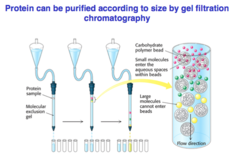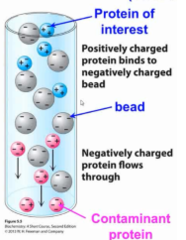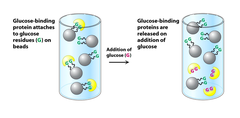Bio tech (EXAM 3) Question set 3- Biopharmaceuticals (Wyatt pg 27-60), – Flashcards
Unlock all answers in this set
Unlock answersquestion
purpose/function of 2 extra agents in denaturing gel
answer
1) beta-mercaptoethanol: used to break disulfide bonds linking cysteines together 2) SDS:detergent that disrupts all other non-covalent bonds (H bonds, van der waals, etc)
question
what are biopharmaceuticals?
answer
*polypeptides* that are used as medicines- forming huge molecules for therapeutic use
question
types of biopharmaceuticals
answer
-hormones: hematopoietic, wound healing, growth -cytokines: act in inflammation/immune sys -enzymes/ERT -antibodies
question
why use biopharmaceuticals?
answer
able to have a treatment option that is otherwise not possible with small molecules or gene/stem therapy yet
question
gene therapy in relation to biopharmaceuticals?
answer
-gene therapy: ultimate delivery of protein therapy--> bc genes tell cell to make the specific protein of interest
question
biopharmaceuticals are *selective* in hormone/cytokine therapy because?
answer
protein interactions are more *specific* and with higher *affinity* than a small molecule with their targets, which makes protein therapy harder
question
ERT (enzyme replacement therapy) in order to?
answer
-catalyze rxn otherwise not possible -as a result of genetic/biochemical defect causing a pathological problem
question
limitations to biopharmaceuticals
answer
-require injection (can't give protein orally bc will be degraded by GI system) -instable, degrade and clearance fast -expensive
question
biosimilar
answer
-acknowledged by ACA in an attempt to get "generics" for biopharmaceuticals -must be only "highly similar" to already approved biological product, but not entirely simiar
question
number of in-process tests done for biopharmaceuticals vs chemical drugs?
answer
bio: 250 in-process tests chemical: 50 in-process tests = more time verifying biopharmaceuticals
question
problem with biosimilar only being "highly similar"
answer
-may cause ADR that brand didn't -leading to immune reaction to original brand drug if switched back? -difficult in ensuring proteins are the same because they are so large and complex
question
EPO glycosylation example?
answer
-turned EPO (endogenous protein) into a biopharmaceutical -normally has 3 N-linked glycosylations and 1 O-linked, but where these were different in the biopharmaceutical it caused ADR in pts receiving it
question
biobetter
answer
protein with a *non-natural* modification(s) that improves the pharmaceutical properties of the original protein =adding something to change the protein and its ADME
question
biobetter ex- PEG
answer
adding PEG groups on proteins as drugs to protect from degradation/enhance solubility, etc
question
Cimzia
answer
already approved biopharmaceutical with non-natural modifications (PEG) to improve drug
question
steps to develop biopharmaceutical
answer
1) isolate RNA from human cells that already expresses the mRNA 2) make double stranded cDNA 3) ligate to vector (plasmid) 4) transfer into host cells so host cells make the protein 5) purify protein from host cells to get protein of interest
question
types of host cells that can express foreign proteins?
answer
-bacterial (E.coli) -yeast -mammalian -carrot root cells
question
what happens to vector/plasmid in mammalian host cells?
answer
gets incorporated into host genome
question
advantages of bacterial/yeast host cells
answer
-easy to grow -higher yield -cheaper than mammalian -plasmids easy to introduce into bacteria or yeast
question
disadvantages of bacterial/yeast host cells
answer
-limited post-translational modifications (bc yeast doesn't do same modifications as humans do) -protein misfolding and solubility (don't have ER chaperones)
question
advantages of mammalian host cells
answer
-do post-translational modifications (*glycosylation*) -proper folding (w/ ER chaperones)
question
disadvantages of mammalian host cells
answer
-difficult to isolate cells that overexpress protein of interest -higher cost -lower yields
question
why is purity a concern?
answer
bc don't want any residual bacterial protein in injection- could cause immune reaction in pt
question
after protein is purified what happens?
answer
must be: -properly folded -catalytically active, if in ERT
question
3 ways proteins differ according to FDA
answer
1) primary AA sequence 2) modification to AA- glycosylation, etc of side chains 3) high order structure- folding
question
hetergenetiy in biopharmaceuticals?
answer
can happen when there are *modifications to AA* = difficult to control and variable activity
question
protein modifications/higher order structure can be affected by?
answer
*environment* -light -temp -moisture -packaging (due to RPh handling them)
question
3 techniques to separate and purify proteins
answer
1) chromatography 2) gel electrophoresis 3) dialysis
question
gel filtration chromatography purpose

answer
separates proteins by *size* (aka size-exclusion chromatography)
question
how does gel filtration chromatography work?
answer
1) polymer beads/gray spheres covalently linked to column 2) load protein mix 3) flow solvent/buffer through -small proteins: enter polymer beads via pores & are held back -large proteins: pass around beads and are able to collect first
question
fraction collecter
answer
at the bottom of the gel filtration chromatography to collect small volumes of liquid flowing through
question
ion exchange chromatography purpose

answer
separates protein by *charge*
question
how does ion exchange chromatography work?
answer
1) polymer beads have a net negative or positive charge 2) AA are negatively or positively charged and the ratio affects overall net charge and pass through channel via repulsion forces -negatively charged beads: negatively charged proteins pass -positively charged beads: positively charged proteins pass
question
how to get remaining proteins off beads in ion exchange chromatography?
answer
bound with *non-covalent* interactions and can increase NaCl concentration to push remaining proteins off
question
ex of negative charged bead
answer
carboxymethyl group (ionized form)
question
ex of positive charged bead
answer
diethylaminoethyl group (protonated form)
question
affinity chromatography purpose

answer
separates proteins *bound by specific molecule* -impt in monoclonal antibodies
question
how does affinity chromatography work?
answer
1) bait molecule is attached to polymer beads- covalently linked 2) protein of interest binds to bait molecule (ex- Glucose) and all other (waste) proteins filter through 3) add more bait molecules to chase off protein of interest (the one that binds to glucose-ex)
question
purpose of gel electrophoresis
answer
-to separate proteins w/ acrylamide gel + buffer solution -matrix acts as sieve to separate proteins (with +/- charges pulsing)
question
technique of gel electrophoresis
answer
1) prepare protein samples (add color dye) 2) load protein samples in gel 3) connect wire and turn on power to make negative and positive poles 4) proteins of different sizes move across matrix at different speeds -smallest: travel farther bc can move easily 5) stain gel to visualize proteins (*last*)
question
representative gel in gel electrophoresis?
answer
-compare protein of interest to "standard/ladder" of proteins with known size
question
how do proteins migrate in gel electrophoresis?
answer
top to bottom -able to see lines/different sizes and densities
question
acrylamide
answer
-most common gel used in electrophoresis -able to change concentration depending on protein being analyzed
question
when to use higher % acrylamdie?
answer
the *smaller the protein* use higher % gel (bc the higher % has a tighter sieve)
question
native (non-denaturing) gel?
answer
used to prevent unfolding of protein and to separate proteins based on *size*
question
denaturing gel?
answer
contains 2 extra agents in the buffer to denature protein 1) beta-mercaptoethanol 2) SDS -included in preparation before loading sample in gel to break up higher order structure (2, 3, 4)
question
non-denaturing vs denaturing gel purpose?
answer
non-denaturing: separates by *shape* denaturing: separates by *molecular weight/mass/number of AA*
question
dimers on non-denaturing vs denaturing gel?
answer
dimer would look bigger on non-denaturing bc it is separated by *shape*
question
Lane 1 in protein purification
answer
contains homogenate/crude cell isolates with many different proteins
question
Lane 2 in protein purification
answer
salt fractionation- simple step in purification to precipitate out unwanted proteins
question
Lane 3-5 in protein purification
answer
show the results after 3 chromotagraphy purification steps
question
what happens in each step of chromatography?
answer
1) unwanted contaminate proteins are decreasing 2) protein of interest is increasing in *density* (intensity of band shows how much protein is in that sample)
question
types/ex of hormones used for biopharmaceuticals
answer
-hematopoietic (EPO) --insulin
question
dialysis (protein purification)
answer
1) using dialysis bag- put concentrated solution from host cell 2) small particles (glucose/bait) will diffuse out of bag- while larger proteins (of interest) won't 3) repeat steps to filter out smaller/unwanted particles until left with only protein of interest in bag
question
evaluation of success in protein purification (3 ways)
answer
1) specific activity (measure activity of enzyme in mg or mcg) 2) yield- how much purified substance you get 3) integrity- if protein is properly folded, etc
question
what happens to protein yield and specific activity after multiple purification steps?
answer
-protein yield *decreases*- bc losing more proteins and only gaining protein of interest -specific activity *increases* bc getting more of active protein
question
Example 1 of biopharmaceutical case study (hormone)
answer
insulin
question
type I diabetes caused by?
answer
-autoimmune destruction of beta cells that produce insulin --> use isolated insulin (from pigs --> humans) to treat
question
structure of human pro-insulin
answer
A + B chain linked with disulfide bonds (3) -C (aka connecting) peptide (must be cleaved)
question
why initially used pork insulin?
answer
bc sequence of AA was only one AA different than human insulin
question
steps of initial production of human proinsulin
answer
1) isolate mRNA from beta cells in pigs 2) produce double strand cDNA 3) cDNA ligated into plasmid 4) put into bacteria to produce proinsulin 5) isolate from bacteria to convert to insulin
question
why can't produce insulin in bacteria?
answer
bc human insulin must undergo post-translational modifications =need to give bacteria cDNA of exact copy of human insulin -biotech companies then do post-translational modification and cleave C-peptide to give active insulin
question
essential post-translational modifications in insulin?
answer
-cut out introns -cleave C peptide with protease
question
2nd generation human insulins?
answer
bioengineered- biobetter
question
what was different with 2nd generation insulin
answer
-contained non-native amino acid changes to accelerate (rapid acting) or prolong (long actin) duration of action
question
Example 2 of biopharmaceutical case study (hormone)
answer
EPO
question
EPO (Erythropoietin)
answer
natural hormone produced in kidneys to stimulate RBC growth
question
kidney failure causes?
answer
anemia= lack of EPO
question
Epoetin Alfa (Epogen, Procrit)
answer
-EPO made into BioRx -first to treat anemia w/ chronic renal failure, now to tx anemia from many conditions
question
how Epoetin produced?
answer
1) EPO cDNA discovered and cloned into mammalian vector 2) transfected into host cells (CHO) 3) cDNA was integrated into genome of host cells 4) host cells transcribe EPO --> protein 5) EPO *glycosylated* and secreted by host cells = harvested, purified, and formulated into drug
question
essential post-translational step in EPO production?
answer
glycosylation
question
difference in post-translational modifications in insulin vs EPO
answer
-insulin: biotech company does them (cleaves C peptide) -EPO: host cell does them (mammalian- CHO)
question
glycosylation of normal EPO
answer
-one O-linked (Serine) -three N-linked (Asparagine)
question
Darbepoetin (Aranesp)
answer
*bioengineered Epoetin* -two extra glycosylation sites to improve 1/2 life in blood -tx: cancer related anemias & *kidney pts not on dialysis*, but recommendations for lower doses
question
why want to improve 1/2 life of biopharmaceuticals (esp EPO)?
answer
bc they are proteins- and rapidly degraded in body -and to decrease amount of injections
question
Example 3 of biopharmaceutical case study (cytokine)
answer
Cytokine ex- Colony Stimulating Factors
question
CSF (colony stimulating factors)
answer
stimulate cell growth -ex: granulocyte- CSF
question
Pegfilgrastim (Neulasta)
answer
*Biopharm version of granulocyte- CSF* -to treat neutropenia (low white blood cell count) -in E.coli cells -added PEG group (after purifcation) to increase half-life and decrease dosing frequency
question
Example 4 of biopharmaceutical case study (Enzyme)
answer
t-PA
question
how does FDA measure pharmacological activity of protein (BioRx)?
answer
*functional assays* -evaluated function of protein in vitro and/or in vivo -must be able to define specific activity
question
t-PA (tissue plasminogen activator)
answer
protease, when *in presence of fibrin* (forms blood clots), converts the enzyme plasminogen to *plasmin*- to break down fibrin in blood clot
question
Alteplase (Activase)
answer
*biopharm version of tPA* -CHO produced -full length t-PA -tx: early signs of MI/stroke
question
process of producing Alteplase
answer
1) isolate cDNA for natural human tPA 2) put into vector (plasmid) 3) integrate into host genome (CHO cell) 4) form protein and extract/purify protein
question
Reteplase (Retevase)
answer
*biopharm version of tPA* -E.coli produced -*truncated version* & non-glycosylated = increases half-life -tx: early signs of MI/stroke
question
process of forming Retplase
answer
1) isolate from E.coli 2) refolded by biotech company
question
Tenecteplase (TNKase)
answer
*biopharm version of tPA* -CHO produced -modifications to natural cDNA (full length) to produce that make it more *specific* in presence of fibrin= decreases side effects -tx: early signs of MI/stroke
question
Tenecteplase modifications to human tPA
answer
-allows it to be more specific *in presence of fibrin* (less active w/o fibrin) =better management/less side effects
question
Example 5 of biopharmaceutical case study (enzyme replacement therapy-ERT)
answer
Pompe disease- alpha-1,4-glucosidase
question
Pompe disease
answer
-due to lack of alpha-1,4-glucosidase (catalyzes breakdown of glycogen) -leads to lysosomes swelling with glycogen =cardiorespiratory failure before 2 yrs old
question
Alglucosidase alpha (Myozyme)
answer
*recombinant human alpha-1,4-glucosidase* -CHO produced -tx: Pompe disease -biotech companies must expose terminal mannose after extraction from CHO cells
question
why Myozyme needs to have terminal mannose (sugar)?
answer
to be able for body to take up drug in lysosomes and accumulate in lysosomes for action to occur
question
what haplotype of alpha-1,4-glucosidase is produced as Myozyme?
answer
*most predominate*
question
Lumizyme
answer
Myozyme made on larger scale (had to change name, and changed glycosylation patterns)
question
ADR of pompe disease drugs (Myozyme & Lumizyme)
answer
-black box warning for possible 1) immune reactions --> must be in hospital to monitor with first dose & infuse over 4 hours 2) cardiorespiratory failure -increased risk of infections
question
Pharmacy considerations of children w/ Pompe disease
answer
-don't want too sedated -vent management/pulmonary meds -rule out infectious causes -intubated for nutrition -evaluate meds due to impaired renal function
question
preparation of Myozome
answer
-no shaking (protein) -avoid foaming -mix in appropriate volume (take air out bag)
question
admin of Myozyme
answer
-infuse over 4 hours -monitor vital signs
question
monitoring w/ Myozyme
answer
-check: IgG antibodies (every 3 months for 2 years, then annually) -liver function tests -vital signs -volume overload
question
pharmacy care (pulmonary)
answer
-RSV prophylaxis (vaccine) -Albuterol
question
Pharmacy care (cardio)
answer
Enalapril
question
Pharmacy care (FEN/GI)
answer
-ergocalciferol -PEG (laxative) -formula for feeds



